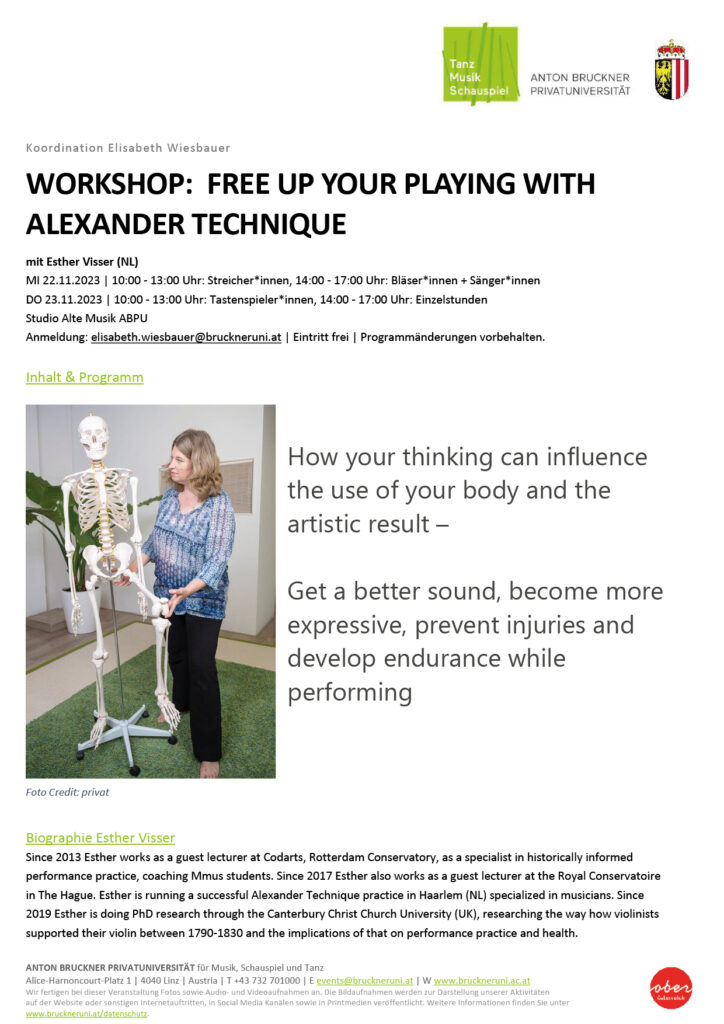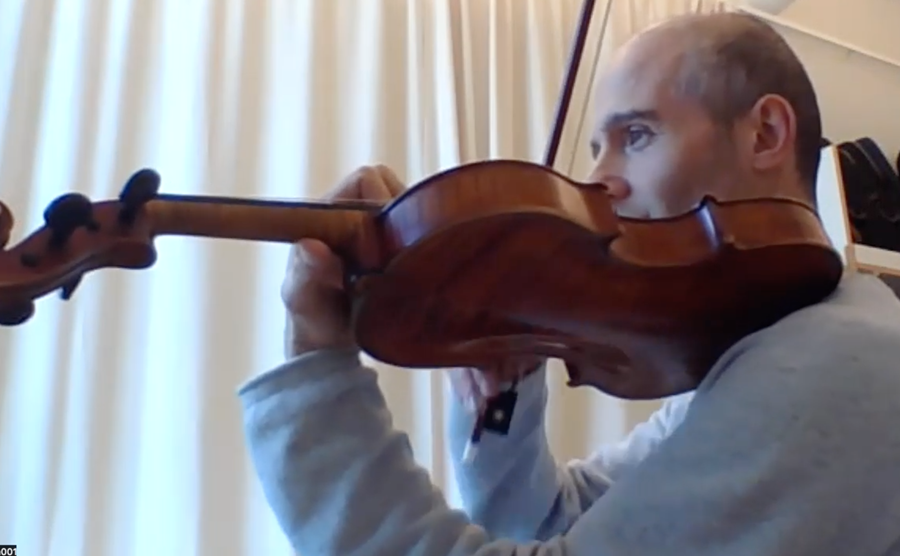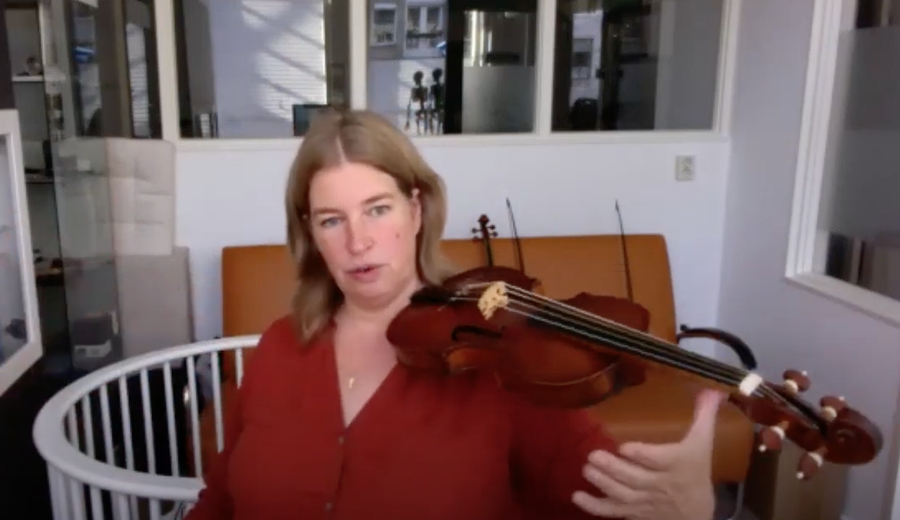
The 22nd week of the experiment
Hi everyone,
This is the 22nd week of the experiment on playing without a shoulder rest and / or chin rest. Here are some updates and some feedback.
Thank you for sending me your videos, it’s really important for my research. Some people just finished the whole 12 lesson program, sent their last video and filled out the exit survey. Fantastic, thank you so much! The majority however is still about 2/3 in the program and that is perfectly fine, please do take all time you need and don’t hurry.
It is still possible to start taking part in the experiment. Many people already filled out the entrance survey. Thanks. If you didn’t do it yet, please do so before you start the lessons.
If you know more people who like to join, for example starting this or next month, this is still possible through my website. If you missed the newsletter last week, you can still read it here. There is a collection of past newsletters at my website available too.
Please be welcome to join the Zoom session next Wednesday 11.00 AM (Dutch time) if you want… Just to meet or to ask some questions. Would be nice to meet up. You can watch Zoom sessions back on the login page where the video lessons are, as well.
“I think your research is very important and I think you are very right on all the points you raised. I am so thankful that your talk about this, because almost every musician has unhelpful habits.”
– Jun Keller, Vienna Philharmonic Orchestra,
participant in the experiment
22nd Zoom session
On March 1st there were technical problems with Zoom, so we had to skip one week, but on March 8th we had a very nice session again.
Nadi from Paris (and Chile), James from Marseille (and Australia) and Ingrid from The Netherlands were taking part. Nadi told us that she is now at lesson 8: playing double stops and using vibrato while balancing the violin. She finds it quite hard, much harder than without double stops! We will work on that in this session. She also tells us that she feels much better playing in orchestra now. She does not have any pain anymore and feels comfortable. The tiredness at the left side of her body, as she told us in the first weeks in this experiment, completely disappeared. Her neck used to suffer a lot, but this feeling is completely gone. I am very very happy to hear that!


Nadi showed us first her vibrato while using one finger and it looked beautiful, slow and in control. When she showed us the vibrato on the double stop (a third with the first and third finger), it became much smaller and faster. I then asked her to do it with the second and fourth finger and that was almost impossible, it seemed like the half of her hand somehow was freezing. Very interesting.

I asked her what she feels and Nadi told us that is feels that she is losing the support from the thumb as soon as she is using the second and fourth finger. My hypothesis was that her thumb was not used enough to support the violin independently. She also said that it felt like she needs to use the side of her first finger.
So I asked her to slide her first and third finger over the strings (as if we go from first to third position and back), but without moving the thumb and keep supporting the instrument with the thumb. That was possible for her. Then we did that with the second and fourth finger. This was more complicated but after a while he ‘discovered’ the freedom in her wrist to do that. In my case, I can easily move to the thord or fourth position with my fingers and leave the thumb were it is, but you need flexibility in your wrist to be able to do that.
Be careful that the thumb is not moving ‘up’ together with the fingers, keep the support of the violin going. So the hand goes away from the thumb. Take care that the violin stays horizontally, not dropping it. Nadi very nicely said ‘my thumb wants to run away’… 🙂


I think the reason that the thumb want to go with the hand (‘run away’) is a stiffening in the wrist. It can help to really imagine the hand moving on top of the arm. The arm itself does not need to move. Like your head moving on your neck. If you do this gliding movement for a few days with the two fingers you use in the double stops, your brain will get used to that idea. The next step is to then let your fingers stay at the same places (fingertips on the same spot on the fingerboard), but make the same movement with the hand. Then you have flexibility in the wrist and freedom to make a smaller, bigger, warmer, colder, faster or slower vibrato.
Nadi is very near to this stage, I feel. She just has to do that for a couple of days. Let us know how it goes, Nadi! 🙂


Ingrid then shared with us that she are and more feels the support of the thumb and that the finger and thumb work together (like magnets) in balancing the violin. She now is applying it already in playing pieces, without losing it. Her question for today was:
“When you kind of ‘lose it’ (the support of the thumb), how do you get it ‘back’ while playing?”
I advised her to use the trick we do with the ‘chin-off’ group in this experiment in the position changes… so we support for a short moment the neck of the violin with the side of the index finger, just to take the thumb back. She can do this (in a performance) to get her thumb back if it slipped next to the neck of the violin. But take care to open the hand again after that!


I also think that the reason Ingrids thumb sometimes is slipping, is that she is using her thumb in a quite ‘straight’ way. It looks like she is not involving the second joint enough. I recommend to involve all joints and that will result in a rounder form of the thumb. Ingrid understood what I meant.

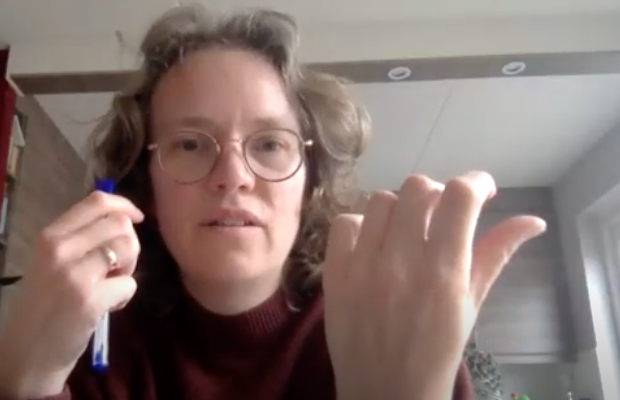
In the video Ingrid sent me about the vibrato, something was interesting to see. Her vibrato was beautiful but she showed it while walking around in the room and I could see that she locked her hips while walking, what resulted in shifting her weight very much from the right to the left. I tried to imitate it in the zoom session. It made me wonder if she perhaps is used to lock her hips while playing standing up and / or sitting down as well. So I suggested to her to practise walking around but really lift the knees high, so that you can feel that the hips are free. Also with sitting down you can lift the knees now and then, to check this. Ingrid recognised herself in my imitation and found it very funny ;-)…


Ingrid also shared that she taught she was doing the experiment very slowly, but I tried to assure her that in fact I think she is managing big changes quite quickly! It was my mistake to think that this other way of balancing can be learned in twelve weeks. We really should see it as a 12 step program which people can do in their own tempo, because it already proves that most of the participants (fantastic players!) need much more time. It also depends on your circumstances and schedule. That is completely fine, no problem. I am not in a hurry and it is a very interesting proces to be involved in. So really take all time you need.

James also had a question:
“When you said ‘keep your violin horizontally’ it helped me a lot, many things get easier, especially shifting… but how to keep that position naturally?”
I think this depends a lot on how well you use your back. This is something you can learn through Alexander technique lessons. If you use your back in a nice and balanced way, to keep your violin horizontally all the time is really not heavy and nor difficult, and it will feel natural after a while when you get used to it. But if there is anything in your back that makes it not ideal to support your arms, then it becomes an effort and it will feel heavy to keep the violin horizontally all the time.

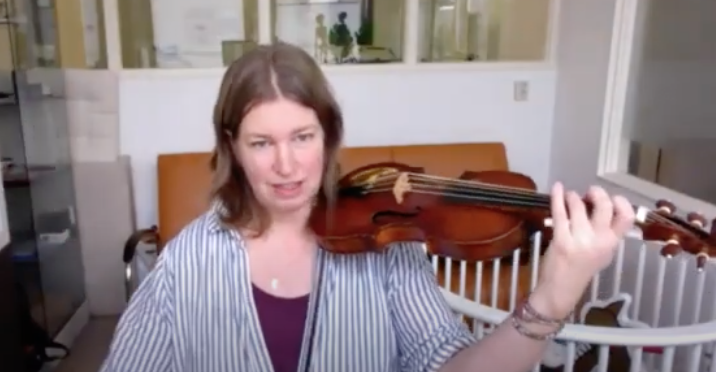
In James’ case, we worked on this while he was here visiting my practice. We spent most time on how to sit in a healthy way in orchestra. He shared with us that he still needs time to integrate this. It was interesting, when he demonstrated this to us, I saw him ‘being pushed away’ by the violin. This is what happens a lot in violin and viola players. As soon as the violin arrives in the direction of the shoulder, the whole spine moves away from the violin, asa kind of compensation. This is really tricky, as the balance of the back and your support of the arms (from the back) will be sabotaged by that. I show it here in an exaggerated way:

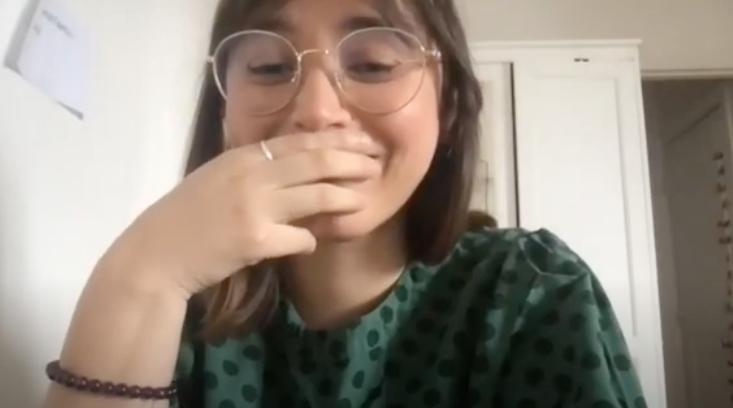
James also shared that he feels he is moving away from the violin when he is playing in higher positions, which is not helpful. These kind of reflexes are interesting to observe in yourself.

To avoid these kind of unhelpful habit happen I suggested to think the head going forward and up, leaving the neck, as I have been practicing with James in his lesson here. The Alexander Technique can very strongly help with this. This is the second direction out of four. The third direction, to think the back lengthening and widening, is also very helpful to develop a strong basis from where the arms can be supported. James shared with us that at this moment thinking the directions while he is practising feels very good, but in concerts it’s just too much. I think that is very normal, after such a small amount of experience with the Alexander Technique. One need to practice it for a bit longer time to feel comfortable enough to also be able to think these directions in concerts. The same with our new way of balancing the violin. This might feel very comfortable in the practice room, but it takes more time to be able to use it during a concert. In such circumstances our body tends to fall back in ‘safe’ old habits.



Nadi agreed with this. She shared that she was freaking out, the first few weeks in this experiment, trying to put everything into practice during concerts. It’s impossible. We all have different backgrounds and different old habits. Her solution for this was to consciously decide to take just one little thing from this experiment and practice that during a rehearsal for example. Not pushing too hard, just make a little change. Then, one day, you will be able to combine two things for example. For her, it was very helpful to approach it like that. I think this is very very true, thank you for suggesting that to all participants, Nadi!
As James told us that for him it’s more difficult for him to keep the violin horizontally while standing, I worked a bit with him on this during this zoom session. We discovered that his atlas (between the ears) was a bit behind his hip bones, not in the same line, which is making things harder. We improved this balance through the Alexander directions. It’s a bit too much to describe it all here in th newsletter, please check the zoom session nr 22 from 0’40 h , to see it, if you are interested in it. We also did it sitting down. It seems like he is compensating, as most people go too much with the head towards the music, but he was going too much backwards. It was bit like this picture I have (see below). the person to the left is pulling her head to much backwards while the picture in the middle is nicely balanced on the spine and the picture to the right is too much forward.


That is one of the big discoveries of F.M. Alexander, that the way our head is balanced on the spine determines the flexibility (or stiffness) in al joints in the body. He also said ‘the opposite of wrong is wrong’… meaning that if you compensate for a not helpful habit, you end up with another not helpful habit. This is what we saw happening with James a bit, I think, but it’s very common and James did great work already during this experiment. James agreed, and added that he is planning to practice the directions more at home. He said that what he learned from making the videos for our experiment is: ‘what you think you are doing is not necessarily what you are doing’.
What I am learning myself from this experiment at the moment, is that it is a kind of dangerous trap to focus too much on arms and hands only. How they function is really dependent on how your back and your whole Self is functioning. When people improve their support from the back, suddenly the left thumb can relax and support the violin better, for example. That is why I am planning to record 6 more videos with only Alexander Technique content, for all participants, as an extra after the 12 lessons (for who wants).
Nadi shared that at this moment she finally plays completely without pain, since she is doing this experiment and attending the weekly zoom sessions. She thinks that that is because we spoke a lot about Alexander Technique, especially in the first lessons. It helped her a lot to think about all these little things that she never really thought about before. So nice to hear, Nadi. She also told us that she is preparing some solo recitals on baroque violin in July in Chile, putting into practice what we do in this experiment, so I invited her to use these zoom sessions a try out possibility, if she likes, and we can give feedback. Would be so nice 🙂

James drew out attention to an article in Strad Magazine from 2019 in which the late Ruggiero Ricci was quoted that he when he was 83 years old he could not hold the violin anymore due to shoulder and back pain, he took of his chin rest. To his amazement he had to change his whole left-hand technique. I knew this article, indeed.
For me, Esther, it is not so surprising that he had to change his left hand technique, and I don’t agree with Ricci in his idea that violinists before the invention of the chin rest all kept their left hand against the ribs of the violin.
However, what is interesting is that Ricci also said: “I wish to point out that with the invention of the chin rest we lost the best features of the old system and any insight into the nature of Paganini’s craft. We learnt to play efficiently the new way but with dire consequences to our necks, shoulders and backs.”
I very much agree with that last sentence!
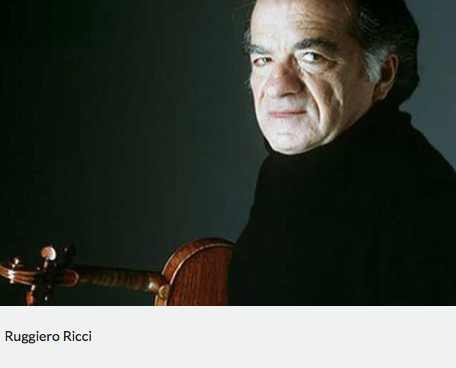
So our goal in this experiment is to use the chin rest in a smart way, only preventing the violin from slipping during big position shifts backwards, but NOT to let it have a function in supporting or carrying the violin. In that way we only take the advantages of the invention of the chin rest and not the disadvantages.
It’s remarkable that when you go and buy a violin, probably all violins at the shop have their chin rests placed at the left side of the tailpiece… as if that is the ‘standard’. Why is this the case? It is facing the head in a very unhealthy position. Anyway… too much to write about in this newsletter.
We also spoke about ‘not making mistakes’. Nadi shared with us a very moving story. She worked in a modern symphony orchestra in Germany for two years. She saw a lot of colleagues suffering and burning out, so afraid of making mistakes. It was shocking for her to see, in her early twenties. Nadi grew up in the ‘El Systema’, in Chile, orchestra was her life, that is all she wanted to do, she loved it. But in that orchestra in Germany, she started to feel sad. So one day she went to her leader and talked about that. He explained to her that life in orchestra (in Germany) is like this: a very cold ambiance, you have to play perfect with no mistakes, and he would not recommend to make any music or to make any friends. Just make money and go home. Nadi cried and told him ‘I am sorry, I didn’t start music for that’ and she left the orchestra. Wow. Of course not all big orchestras are like that. We also have very nice experiences, especially in chamber orchestras. After that we had a nice discussion about blending in the group etc, but now I stop writing.
Please take your time
It is important that everyone in this experiment enjoys the curiosity we have, and take part in a joyful and playful way. In that way, we learn the best. Don’t try too much to ‘do it right’…and don’t hurry. If you need more time, just let me know, keep me informed, and we take a bit longer. No problem!
Best regards, please let me know if you have questions,
Esther Visser




